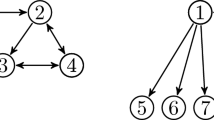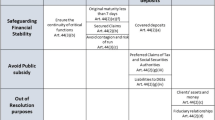Abstract
When both the buyer and seller have the potential to exercise opportunistic behavior some balancing of these mal-incentives must be found. Seller financing has the potential to work as a quality assurance device because the lien holder is clearly at risk when mortgaged property fails. The buyer is at risk in the amount of the down payment and installments if the property is abused. Credit bureaus act as arbitrators. Our model accurately predicts the shifting in contract terms to account for relative opportunism and the incidence of this contract based on changes in the relative costs and benefits.
Similar content being viewed by others
References
Anderson, J.E. and Gollop, F.M. (1984). The effect of warranty provisions on used car prices. In P.M. Ippolito and D.T. Scheffman (Eds.),Consumer protection economics, 67–102. Washington, DC: Federal Trade Commission.
Cooper, R. and Ross, T.W. (1985). Product warranties and double moral hazard.Rand Journal of Economics 16 (Spring): 103–113.
Corbin, A.L. (1952).Contracts. St. Paul, MN: West Publishing Co.
Courville, L. and Hausman, W.H. (1979). Warranty scope and reliability under imperfect information and alternative market structures.Journal of Business 52 (July): 361–378.
DeJong, D.V., Forsythe, R. and Lundholm, R.J. (1985). Ripoffs, lemons, and reputation formation in agency relationships: A laboratory market study.Journal of Finance 40(July): 809–823.
Gerner, J.L. and Bryant, W.K. (1980). The demand for repair service during warranty.Journal of Business 53(October): 397–414.
Gillis, J.The Car Book 1989. New York: Harper and Row.
Grossman, S. (1981). The informational role of warranties and private disclosure about product quality.Journal of Law and Economics 24(December): 461–484.
Kambhu, J. (1982). Optimal product quality under asymmetric information and moral hazard.Bell Journal of Economics 13 (Autumn): 483–492.
Klein, B., Crawford, R. and Alchian, A. (1978). Vertical integration, appropriable rents, and the competitive contracting process.Journal of Law and Economics 21 (October): 297–326.
Klein, B. and Leffler, K.B. (1981). The role of market forces in assuring contractual performance.Journal of Political Economy 89: 615–641.
Mann, D. and Wissink, J. (1983, April). Inside vs. outside production: A contracting approach to vertical integration. Mimeo. University of Pennsylvania.
Metcalf, J. and Diehl, J. (1979). An economic analysis of the FTC's holder in due course rule. Mimeo. University of Miami Law and Economics Workshop.
Palfrey, T.R. and Romer, T. (1983). Warranties performance, and te resolution of buyer-seller disputes.Bell Journal of Economics 14: 97–117.
Palfrey, T.R. and Romer, T. (1984). An experimental study of warranty coverage and dispute resolution in competitive markets. In P.M. Ippolito and D.T. Scheffman (Eds.),Consumer protection economics, 307–372. Washington, DC: Federal Trade Commission.
Spence, A.M. (1977). Consumer misperceptions, product failure, and producer liability.Review of Economic Studies 44: 561–572.
Telser, L. (1980). A theory of self-enforcing agreements.Journal of Business 53: 27–44.5.
White, H. (1980). A heteroskedasticity-consistent covariance matrix estimator and a direct test for heteroskedasticity.Econometrica 48: 817–838.
Author information
Authors and Affiliations
Additional information
Helpful comments were received from M. Gerety, R.D. Sauer, C.M. Lindsay, R.E. McCormick, J.H. Mulherin, R. Staaf, T.B. Yandle and a referee.
Rights and permissions
About this article
Cite this article
Laband, D.N., Maloney, M.T. A theory of credit bureaus. Public Choice 80, 275–291 (1994). https://doi.org/10.1007/BF01053221
Accepted:
Issue Date:
DOI: https://doi.org/10.1007/BF01053221




